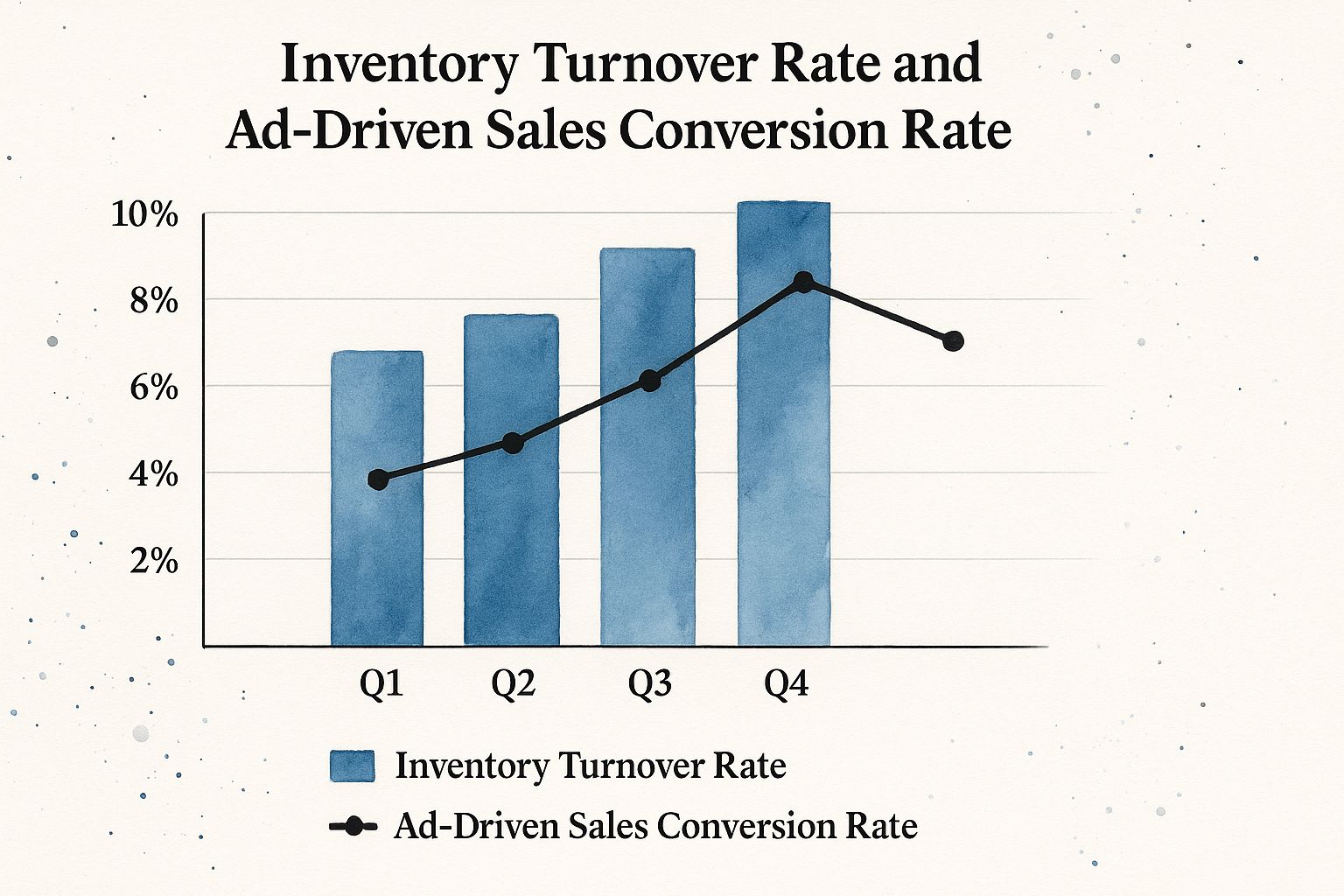The Evolution of Inventory Advertising: What's Working Now

Inventory advertising has changed dramatically. Instead of just placing ads, it's about strategically managing placements within a complex digital environment. Conversations with media buyers, advancements in data analysis, and the rise of powerful algorithms drive this shift. This means traditional approaches are losing their effectiveness, creating new opportunities for adaptable brands.
Understanding Inventory Types
Modern inventory advertising requires understanding the different types of available inventory. These distinctions significantly impact campaign performance and budget allocation. The main types include premium inventory, remnant inventory, and guaranteed inventory.
-
Premium Inventory: This is the most desirable ad space, often found on high-traffic websites or in prominent positions. Its potential for greater reach and engagement typically results in a higher price. It’s the advertising world's equivalent of prime real estate.
-
Remnant Inventory: This is unsold ad space that publishers offer at discounted rates. While cheaper, it may not reach the same audience quality as premium inventory. It's like finding a last-minute deal on a hotel room – it might not be perfect, but it serves its purpose.
-
Guaranteed Inventory: This involves reserving ad space in advance, ensuring placement and visibility. While offering predictability, it often comes at a fixed cost, similar to booking a flight in advance – your seat is secure, regardless of later price changes.
The Rise of Algorithmic Advertising
The move towards data-driven decisions is undeniable. It fuels the global advertising industry’s growth, especially within inventory advertising. Global ad spending reached approximately $772.4 billion in 2024 and is projected to exceed $1.1 trillion by the end of 2025. Find more detailed statistics here. This highlights the increasing importance of advertising in business today. Nearly 60% of 2024's ad spending was algorithmically driven, with projections nearing 80% by 2027.
Embracing the Future of Inventory Advertising
This increasing reliance on data and algorithms means understanding your audience is crucial. Analyzing their behavior, preferences, and online habits is essential for effective inventory advertising. By understanding which platforms and inventory types resonate with your target audience, you can optimize campaigns for maximum ROI. These data insights allow brands to capitalize on inventory opportunities others might overlook, maximizing the impact of every advertising dollar. This data-forward approach differentiates successful inventory advertising campaigns from those that underperform.
From Manual To Automated: Transforming Your Approach

The advertising world, especially inventory advertising, has changed drastically. We've moved from manual tasks to automated systems. Think about it: we used to call publishers directly to place ads. Now, we use real-time bidding and programmatic buying. This shift changes how brands run campaigns, find inventory, and track their wins.
Navigating The Automated Ecosystem
Successful brands are adopting automation. They recognize the value of AI in today's inventory environment. They use platforms like programmatic advertising platforms and machine learning algorithms. This helps them streamline buying, optimize campaigns, and target better, leading to efficient scaling and better ROI. But there are new hurdles too, like keeping brands safe and ensuring transparency in these complex systems.
Balancing Automation And Control
One of the biggest challenges is finding the right mix of efficiency and control. Programmatic buying is incredibly efficient, letting advertisers reach huge audiences on many platforms. But relying only on automation can be risky for brands. For example, an ad might end up next to questionable content, hurting the brand's image. Smart advertisers are finding ways to stay in control while still using automation's benefits.
Inventory advertising has seen a huge increase in automated, data-driven buying. In 2020, global ad spending was about $601.84 billion. By 2025, digital ad spending was expected to hit $700 billion – a big jump. Explore this topic further. This growth is closely tied to innovations like programmatic buying, now used in 90% of global digital display ad buys. These numbers show how important automated systems are becoming in advertising.
Transparency and Measurement In The Age Of Automation
Automated inventory advertising's complexity brings new challenges for transparency and measurement. It's hard to know exactly where ads run and how they perform. This makes it tough to see your return on investment. So, savvy advertisers are creating new ways to ensure transparency and measure campaigns effectively.
They're using key performance indicators (KPIs) that provide useful data and show the real impact of their ad spend. These KPIs include things like viewability, engagement, and conversion rates. This gives them a complete picture of how their campaigns are doing.
Digital Inventory Mastery: Platforms That Deliver Results
Knowing where to put your advertising budget is key for a strong return on investment. Not all digital inventory is the same. Some platforms consistently outperform others, delivering exceptional results. The challenge lies in finding these prime opportunities before the competition.
Identifying High-Performing Inventory
Different inventory types perform better depending on the industry and who you're trying to reach. Understanding these nuances is crucial for effective inventory advertising. For instance, video inventory might work well for a lifestyle brand targeting a younger demographic on platforms like TikTok or YouTube. A B2B software company, however, might find more success with sponsored content or native advertising on LinkedIn. Recognizing these differences is key to a successful campaign.

The infographic above shows inventory turnover rate and ad-driven sales conversion rate over four quarters. Notice how a higher inventory turnover rate often correlates with a higher conversion rate. This underscores the importance of efficient inventory management for driving sales.
Exploring Different Inventory Formats
Each digital platform offers unique inventory formats, each with its own set of advantages and disadvantages. Understanding the specifics of display, video, native, and social inventory is essential. Newer formats like Connected TV (CTV) are also becoming increasingly popular, offering new opportunities for advertisers. Factors to consider include audience reach, engagement patterns, and pricing models for each format.
Choosing the right inventory depends on your campaign goals. Are you focused on brand awareness, website traffic, or lead generation? The answer will guide your platform and format selection. Just like learning how to automate customer service, transitioning from manual to automated inventory management requires a shift in approach and adopting new technologies.
Capitalizing on Shifting Consumer Behaviors
Consumer behavior is always changing, impacting the value of different inventory types. Digital advertising inventory currently dominates the global market, making up nearly 73% of worldwide ad spend. Online advertising expenditure exceeded $790 billion in 2024, a 7.3% year-over-year increase and a remarkable 50% surge since 2019. Learn more about this trend. This growth is directly tied to inventory advertising, which uses digital platforms for real-time bidding and programmatic buying. Staying ahead of these trends is crucial.
Adapting to the Evolving Inventory Landscape
Staying informed about these market shifts is key to success. The rising popularity of streaming services, for example, is increasing the demand (and likely the cost) for CTV inventory. By understanding these shifts, advertisers can take advantage of emerging opportunities and secure valuable inventory before prices rise. This allows for maximum budget efficiency and a competitive edge.
Understanding Platform-Specific Nuances
Each platform targets a different audience and has unique advertising features.
To help you compare, here's a table summarizing the performance of different digital ad inventory formats:
Digital Advertising Inventory Performance by Format
Comparison of different digital ad formats showing their market share, engagement rates, and cost efficiency metrics
| Ad Format | Market Share (%) | Engagement Rate (%) | Average CPM ($) | YoY Growth (%) |
|---|---|---|---|---|
| Video | 35 | 2.5 | 25 | 15 |
| Display | 25 | 0.8 | 12 | 5 |
| Native | 15 | 1.2 | 18 | 10 |
| Social | 20 | 1.5 | 15 | 8 |
| CTV | 5 | 3.0 | 30 | 20 |
This table represents illustrative average values and can vary based on specific industry, targeting, and campaign parameters.
As you can see, CTV, despite its smaller market share, boasts the highest engagement rate and significant growth, but also comes at a premium CPM. Video holds the largest market share and strong growth, while display offers the lowest CPM but also lower engagement. Understanding these trade-offs is crucial for optimizing your strategy.
-
Google Display Network: Offers broad reach and diverse inventory.
-
YouTube: Dominates online video and provides targeted video campaign opportunities.
-
Facebook & Instagram: Offer granular targeting and a massive user base.
-
LinkedIn: Best for reaching professionals in B2B.
-
CTV Platforms: Provide access to a growing audience of cord-cutters and streaming enthusiasts.
Understanding the strengths of each platform enables strategic budget allocation and maximizes campaign impact. This includes optimizing bids, targeting, and ad creatives to resonate with each platform's audience.
Programmatic Inventory Advertising: Breaking Through Barriers

Programmatic inventory advertising goes beyond simply automating ad buys. Smart brands leverage it strategically to achieve remarkable results. This exploration dives into the heart of the programmatic world, illuminating common campaign shortcomings and offering solutions to avoid them.
Understanding the Programmatic Ecosystem
The programmatic landscape is a dynamic marketplace with key players. These include Demand-Side Platforms (DSPs), where advertisers purchase ad inventory; Supply-Side Platforms (SSPs), where publishers offer their inventory; and Data Management Platforms (DMPs), which store and organize audience data.
Knowing how these platforms interact is essential for programmatic success. Think of it as a three-part system where each component plays a distinct role.
DSPs empower advertisers to target specific audiences across various websites and apps. SSPs help publishers optimize their ad revenue by efficiently selling their available ad space. DMPs allow advertisers to refine targeting using valuable audience insights. This interaction enables precise and effective inventory acquisition.
Real-Time Bidding vs. Programmatic Direct
Programmatic inventory advertising offers diverse buying strategies, including real-time bidding (RTB) and programmatic direct. RTB resembles an auction, where ad space is bought and sold within milliseconds based on real-time bids.
Programmatic direct, conversely, involves pre-arranged agreements between advertisers and publishers, providing more control and guaranteed inventory. Selecting the best method depends on your specific campaign objectives.
RTB excels for campaigns prioritizing reach and efficiency. Programmatic direct suits premium inventory and brand safety needs. Other options like private marketplaces and preferred deals blend these two approaches. For further insights into video ad strategies, check out this resource: How to master video ad inventory strategies. Understanding these options allows advertisers to fine-tune strategies for optimal outcomes.
Addressing Common Programmatic Challenges
Programmatic advertising has its hurdles. Viewability, brand safety, and transparency are common concerns. Viewability addresses whether an ad is actually seen by a user. Brand safety prevents ads from appearing alongside unsuitable content. Transparency ensures clarity on ad placement and expenditure.
These challenges can be overcome with strategic planning and the right tools. Viewability improves with tracking tools and placement optimization. Brand safety is enhanced by partnering with brand safety vendors and using exclusion lists. Transparency increases when working with trusted partners and demanding clear reporting. These actions empower brands to maximize campaign effectiveness and safety.
Data-Driven Inventory Optimization That Actually Works
Moving beyond basic targeting means understanding how leading advertisers use data to make informed inventory decisions. This data-driven approach helps them significantly outperform the competition. Through real-world examples of successful campaigns, we’ll explore how first-party data, second-party data, and third-party data inform inventory valuation and audience targeting.
Optimizing Inventory with Data
Several optimization techniques deliver measurable results. Sophisticated audience segmentation, for example, allows advertisers to divide their target audience into smaller, more focused groups based on demographics, interests, or behaviors. This precision targeting ensures ads reach the most receptive individuals, maximizing engagement and conversions.
Another powerful technique is contextual targeting, valuable in today's privacy-focused environment. This strategy focuses on placing ads on websites or within content relevant to the product or service. For example, a travel company might advertise on travel blogs or websites featuring travel articles. This placement ensures the ads are seen by an audience already interested in travel, increasing engagement. Read also: How to Create Video Ads That Convert.
Navigating the Privacy-First World
Privacy regulations like GDPR and CCPA are reshaping targeting capabilities. The decline of third-party cookies presents a challenge to traditional targeting. Smart advertisers are adapting by prioritizing first-party data strategies. This involves collecting data directly from their customers through website interactions, CRM systems, and other owned channels. This data offers valuable insights into customer behavior and preferences, enabling more effective targeting without relying on third-party cookies.
The Power of AI and Machine Learning
AI and machine learning are changing inventory optimization. These technologies analyze large amounts of data to identify patterns and predict future trends. This allows advertisers to automate bidding strategies, personalize ad delivery, and optimize campaigns in real-time. AI can also improve contextual targeting by analyzing website content and identifying the most relevant ad placements.
Understanding Data Sources
Different types of data offer unique advantages for inventory advertising. The following table, "Inventory Advertising Data Sources and Applications," provides an overview of these data types, their sources, applications, and effectiveness while considering privacy implications.
| Data Type | Common Sources | Primary Applications | Effectiveness Rating | Privacy Considerations |
|---|---|---|---|---|
| First-Party Data | CRM systems, website analytics, customer surveys | Personalized advertising, retargeting, customer loyalty programs | High | Requires robust data management and compliance with privacy regulations |
| Second-Party Data | Partner companies, data sharing agreements | Expanding audience reach, targeted campaigns | Medium | Requires careful vetting of partners and data quality |
| Third-Party Data | Data aggregators, market research firms | Broad audience targeting, market analysis | Low (decreasing) | Subject to increasing privacy restrictions and data accuracy concerns |
As shown in the table, first-party data offers the highest effectiveness due to its direct connection to customer behavior, but it requires careful data management. Second-party data provides a way to expand reach while maintaining some level of targeting. Third-party data, while useful for broad targeting, is facing increasing scrutiny due to privacy concerns.
By understanding the strengths and limitations of each data source, advertisers can build a robust data strategy that effectively targets their desired audience while respecting user privacy. This data-driven approach is essential for successful inventory advertising.
Measuring What Matters: Inventory ROI Beyond The Basics
Stop fixating on surface-level metrics. Instead, begin measuring the factors that truly drive your bottom line. By studying successful campaigns, we can identify which key performance indicators (KPIs) actually signal success with inventory advertising and which popular metrics can be misleading. This knowledge is essential for strategic decision-making and campaign optimization.
Identifying The Right KPIs
Many advertisers get caught up tracking vanity metrics such as impressions or clicks. While these offer a glimpse into campaign performance, they don't always reflect real business results.
Focus on metrics directly aligned with your business goals. For example, if you're aiming to boost sales, prioritize conversion rates and return on ad spend (ROAS). If brand awareness is your main objective, track metrics like reach, engagement, and brand lift.
Implementing Effective Attribution Models
Accurately evaluating inventory advertising requires attribution models that appropriately credit every touchpoint in the customer journey. This means moving past the last-click attribution model, which solely credits the final interaction before a conversion.
Consider models like multi-touch attribution, which distributes credit across all touchpoints. This provides a more complete view of each interaction's contribution to the final conversion. You might find this resource helpful: How to Master Automating Content Creation with Smart AI Tools.
Tackling Measurement Challenges
Measuring inventory advertising effectiveness can be challenging. Obstacles like cross-device tracking, online-to-offline attribution, and incrementality testing demand robust solutions.
Cross-device tracking lets you follow user behavior across their various devices, providing a fuller understanding of how they interact with your ads. Online-to-offline attribution links your digital advertising efforts with offline conversions, like in-store visits. Incrementality testing reveals the true impact of your campaigns by comparing performance against a control group. To gauge the effectiveness of your inventory advertising, measurement is crucial. This article offers helpful strategies: Measuring Content ROI.
Calculating True ROAS
Calculating true ROAS means accounting for both immediate conversions and the long-term value of customers acquired through your inventory advertising. This long-term value often encompasses repeat purchases, customer lifetime value, and brand advocacy.
By incorporating these elements, you gain a more complete understanding of your inventory advertising investment's overall impact. This allows for more strategic budget allocation and campaign refinement.
The Future of Inventory Advertising: Stay Ahead of the Curve
The inventory advertising landscape is in constant flux. Staying competitive means not just keeping up with current trends but anticipating what's next. This requires a forward-looking approach, exploring emerging technologies that will reshape how we think about inventory advertising.
Emerging Technologies Reshaping Inventory Advertising
Several key technologies are on the cusp of transforming how brands manage and leverage inventory. AI-powered valuation, for example, uses data analysis to deliver more precise and responsive inventory pricing. This empowers advertisers to fine-tune bids and stretch their budgets further. Blockchain technology offers another exciting development, bringing greater transparency and security to inventory transactions. This helps to mitigate fraud and foster trust within the advertising ecosystem.
The Rise of First-Party Data
With the decline of third-party cookies, first-party data strategies are more vital than ever. Proactive brands are already developing robust systems for collecting and using their own customer data. This approach not only offers invaluable insights into audience behavior but also enables personalized advertising experiences. Personalization leads to increased engagement and strengthens customer relationships. It also prepares brands for a future where third-party data is less accessible. This shift has direct implications for inventory purchasing decisions, allowing for more strategic and targeted investments.
Breakthrough Inventory Formats
New and captivating inventory formats are continually appearing. Interactive experiences, shoppable video, and augmented reality (AR) placements are gaining momentum, providing consumers with more immersive and engaging brand interactions. Shoppable video, for instance, lets viewers buy products directly from a video ad, streamlining the purchase process and driving conversions. AR placements offer interactive product visualization within the consumer's own environment.
Retail Media Networks: A New Inventory Source
Retail media networks are becoming increasingly important inventory sources. These networks utilize retailers' first-party data, giving advertisers access to highly engaged audiences. This is especially valuable for reaching consumers actively seeking to make a purchase. As competition within these networks intensifies, however, strategic action is essential. Early adoption can secure advantageous positioning and pricing before costs escalate and effectiveness decreases.
Staying Ahead of the Curve
The future of inventory advertising will reward those who are adaptable and innovative. By understanding the trends discussed here, brands can anticipate upcoming changes and capitalize on the opportunities they present. Embracing these technologies and strategies will be critical for maximizing ROI and achieving sustained growth. Ready to revamp your video content strategy? Explore Aeon, the AI-driven video creation platform built for publishers.